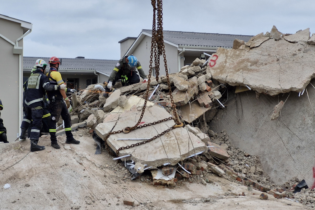We all know someone who has either lost their life or suffered a life-changing injury due to a road traffic accident. And yet when we step back and think about it, we realise that every accident is indeed preventable, writes Verushka Balaram, Head: Road Safety and Design Investigations at ARRB Systems, who expands on engineered solutions.
The simple truth is that our road transport system’s level of safety is inadequate and more must be done to tackle this real pandemic. If we consider the problem globally, around 1.3 million lives are lost due to road traffic accidents each year. The majority of these fatalities occur in low- to middle-income countries. According to the World Health Organization, road traffic injuries remain the leading cause of death among children and young adults aged 5-29 years. In South Africa, we needlessly lose over 14 000 people annually. The holiday periods in December and Easter are typically when crash rates are at their peak, and media coverage of horrific fatal crashes is a daily occurrence. So, who, or what, is to blame? And how do we tackle this pandemic?The Safe System
Road safety is ultimately a shared responsibility. The Safe System approach, which was first adopted by Sweden and the Netherlands, recognises that road transport is a complex system and places safety at its core. It recognises that humans, vehicles and the road infrastructure must interact in a way that ensures a high level of safety. We are human, and we will make mistakes, but we should not lose our lives for it! The Safe System thus requires all stakeholders to act responsibly to realise a safer roads environment. From an engineering standpoint, the Safe System must:- incorporate road designs that anticipate and accommodate human errors, and limit crash dynamics to levels that are within human tolerance to prevent death or serious injury
- pursue a commitment of proactive and continuous improvement of road networks so that the entire system is made safe, rather than just locations or situations where crashes last occurred
- motivate those who design and maintain the roads, and administer safety programmes, to share responsibility for safety with road users, so that when a collision occurs, remedies are sought throughout the system, rather than solely blaming the driver or other road users
- adhere to the underlying premise that the transport system should produce zero deaths or serious injuries and that safety should not be compromised for the sake of other factors such as cost or the desire for faster transport times.
Reactive vs proactive approach
Safety plans that are based on crash data to identify areas where clusters of serious accidents have previously occurred, or ‘black spots’, are reactive and insufficient to support a Safe System approach. There is a high reliance on good-quality data, which is not always available. As such, black spots may constitute just a fraction of the entire road network; other unsafe areas, which only become evident after serious crashes, are not identified until it is too late. Conversely, safety plans developed by focusing on fundamental flaws in designs and those inherent in existing roads are proactive and can identify where serious road accidents are likely to occur. Road Safety Audits (RSAs) and the International Road Assessment Programme (iRAP) both offer proactive approaches for road infrastructure safety management. RSAs are particularly effective during the design and construction stages of a road project, where the focus can be on future crash prevention by mitigating potential hazards before the road is opened to the public. An independent, qualified team examines road user and traffic interactions to determine the crash potential and severity, which are combined to determine the level of risk and associated remedy. RSAs are performed at any of the following stages:
- Stage 1: Feasibility/Preliminary Design
- Stage 2: Draft Design
- Stage 3: Detailed Design
- Stage 4: Construction Work Zone
- Stage 5: Pre-opening
- Stage 6: Post-construction: Existing Road (Road Safety Appraisal).
iRAP methodology
The iRAP methodology is typically performed at the network level and is an evidence-based approach to identify and address hazardous road locations, providing an in-depth understanding of the level of safety evident on each road. iRAP assessments require a digital survey of the road with an approved inspection system, such as the ARRB Systems Hawkeye 2000 Network Survey Vehicle (NSV). However, if the roads agency is already collecting condition data for its RAMS with the NSV, then thereis no need for a separate safety survey, as the same data can be used, making the process economical. The surveyed data is used for the assessment of more than 52 roadside attributes and is combined with supporting information such as speed data, vehicle and pedestrian flow data, and traffic volumes. This produces ‘Star Ratings’, which is the global benchmark used to estimate risk that a person – whether a vehicle occupant, motorcyclist, cyclist or pedestrian – will be killed or seriously injured. 1-Star roads and designs have the highest infrastructure-related risk, while 5-Star roads have the lowest. iRAP incorporates the use of a free online portal (ViDA), where users can upload road inspection data, produce detailed road condition reports, Star Ratings and Safer Roads Investment Plans. iRAP also conforms to the UN’s Global Road Safety Performance Targets 3 and 4, which state that by 2030, all new roads, and more than 75% of travel on existing roads, must achieve at least a 3-Star rating. In South Africa, ARRB Systems’ iRAP-accredited team has undertaken safety assessments on more than 20 000 km of provincial and municipal roads. These agencies are seeing the benefit of iRAP network assessments to develop a priority list of safety countermeasures to both motivate for funding and use as an implementation strategy. Additionally, iRAP assessments can monitor road safety performance so that both National Treasury and the roads agency can assess the benefits of their investments over time.
Pros and cons
Both RSAs and iRAP have their advantages and disadvantages. For example, RSAs can be done at night and there isn’t a limit to the level of detail that can be considered. However, the level of subjectivity can lead to inconsistent outcomes and long road sections can prove challenging for the assessment team. The main benefit of the iRAP methodology is that there is no need to undertake an entirely separate data gathering exercise. Imagery and much of the associated data is already collected as part of the roads agency’s pavement management system, so there is no duplicated cost to re-survey the road network. The iRAP assessment provides the road network manager with a holistic overview of the network’s level of safety and identifies hazardous locations, often not known to the roads agency. However, the list of assessed attributes, though comprehensive, is fixed, and the quality of the results depends on the quality of the input data, making the process reliant on strict protocols. Whichever approach is used, the critical aspect is that action is taken, and loss of life is prevented! Safety assessments are meaningless without implementation. Roads agencies must lead and facilitate road safety strategies as a priority. Leadership is thus intrinsic in implementing correct reforms to accommodate advances in technology and best practices.







